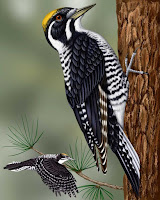![]() |
| Black-backed W.P. |
![]() |
| Three-toed W.P. |
There are five species of
WOODPECKERSfound on our island: Downy Woodpecker (our smallest), Hairy Woodpecker (like the downy but a longer beak, about the size of a robin with a comma shaped black mark from shoulder to breast), Pileated Woodpecker (the largest and hence the loudest), Northern Flicker (which more resembles a dove and is the most common and the only W.P. that feeds on the ground), and the Red-breasted Sapsucker (they do not suck sap as their name implies, but rather lick the sap using small hair like projections on the tip of the tongue).
With their hard, pointed beaks, incredibly long tongues and thick, shock-absorbing skulls (one wonders why they are not brain-damaged), woodpeckers are well adapted for excavating cavities for nesting and roosting, territorial drumming, and hunting for insects and sap. Woodpeckers are made for tree living with their sharp pointed claws aiding them in scaling up and down trees. They have a short, stiff tail that helps prop them up when they are climbing. They are one of the most fascinating birds to watch.
Woodpeckers play an important role in the health of our forests. Abandoned cavities are used by a variety of other birds and the process of drilling and chipping for food and shelter also contributes to the necessary decomposition of dead trees.
![]() |
| Red-breasted Sapsucker |
During breeding season (April-June) male woodpeckers will drum on loud surfaces to establish their territory and attract a mate. Favorite sites for this kind of "rat-a-tat-tat" drumming are gutters, downspouts and flashing. For several years we have had a Red-breasted Sapsucker going to town on the copper finial atop the monastery roof, totally driving our PWD, Koko, nuts!
As seen in 5/12 Blog I recently added the lovely White-headed W.P. to my list (WA). In my travels to Arizona I have seen the Gila, Strickland's and Arizona W.P., and Gilded Flicker and Red-naped Sapsucker. In California there are the Acorn and Nuttal's W.P. and Williamson's Sapsucker; in Texas the Ladded-backed & Gold-fronted and in CT the Red-headed and Red-bellied W.P. and the Yellow-bellied Sapsucker.
So now? Who else is out there? After Labor Day I will be setting out with birding friends to the Okanogan areas of WA and Canada to try and find the
Black-backed Woodpecker and the
Three-toed Woodpecker, two of our most northern birds and the elusive
Lewis' WP.
![]() |
| Black-backed WP- Tom Munson |
The
Three Toed Woodpecker moves into areas with large numbers of insect-infested trees, often following a forest fire or flooding. Since we are in the worst forest-fire season in history we may have a chance to see one of these beauties flying our way! This bird is likely to give way to the
Black-backed Woodpeckerwhere the two species compete for habitat. Their breeding habitat is boreal forest across Canada, Alaska and the north-western United States. Black-backed woodpeckers are generally non-migratory and are common in southern British Columbia where we will be.
![]() |
| Three-toed WP |
The call note of the Black-backed woodpecker is a single, sharp pik, and is lower pitched than the call of the American three-toed woodpecker. Both species have yellow tops so here's hoping we find one and then make the right identification!
One of the largest species of American woodpeckers,
Lewis's Woodpeckercan be as large as 10 to 11 inches in length. It is mainly reddish-breasted, blackish-green in color with a black rump. It has a gray collar and upper breast, with a pinkish belly, and a red face. The wings are much broader than those of other woodpeckers, and it flies at a much more sluggish pace with slow, but even flaps similar to those of a crow.
![]() |
| Lewis" WP |
Unlike other American woodpeckers, it enjoys sitting in the open as opposed to sitting in heavy tree cover. Lewis's woodpecker engages in some rather un-woodpecker-like behavior in its gregarious feeding habits. Although it does forage for insects by boring into trees with its chisel-like bill, the bird also catches insects in the air during flight, a habit that only a few other woodpeckers indulge in. It will be easier to identify- it does not have a yellow top!
![]() |
| Lewis' WP in full glory |






